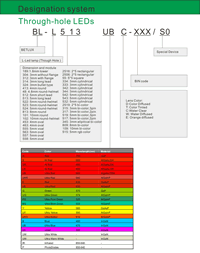Discrete LED
Series No:
Weight:(g/pcs)
Dimension:(mm)
Package:
Specification:
Inquiry
Description:
Introduction: The Revolution of High Power LED Batwing Type
The Batwing type of High Power LEDs revolutionizes how light is distributed across wide areas, making it an indispensable technology in various industries. By offering a unique batwing-shaped beam pattern, these LEDs provide uniform light distribution, enhancing efficiency and coverage. The focus on “640nm” LEDs within this category further accentuates the demand for specific wavelengths in applications requiring precise color rendering and intensity.
Unveiling the Features of High Power LED Batwing Type
Characterized by their wide beam spread, High Power LED Batwing Types are engineered for applications that require broad light distribution without sacrificing intensity. Their ability to emit light in a batwing pattern allows for uniform illumination across large spaces, minimizing dark spots and overlapping areas. This, combined with the “640nm” wavelength, makes them particularly useful in applications where vibrant red lighting is crucial.
Applications: Broadening Horizons with Batwing LEDs
From architectural lighting to agricultural growth enhancement, the applications of Batwing High Power LEDs are vast and varied. In retail, for example, the “640nm” LEDs can be used to highlight products in a warm, inviting glow, while in agriculture, the same wavelength promotes plant growth, showcasing the versatility of these LEDs.
The Advantages: Illuminating the Benefits
The use of High Power LED Batwing Type brings forth numerous benefits, including energy efficiency, enhanced area coverage, and reduced installation costs due to fewer fixtures required for uniform lighting. Additionally, the specific “640nm” wavelength LEDs offer advantages in applications requiring targeted light spectra, such as in bio-light therapy and photography.
Case Studies: Lighting the Way with Innovation
Real-world case studies provide tangible evidence of the impact of High Power LED Batwing Type. One notable example includes its use in a commercial parking lot, where its wide beam pattern significantly improved visibility and safety, reducing the number of fixtures needed.
Hearing from the Field: User Testimonials
Feedback from industry professionals who have implemented High Power LED Batwing Type in their projects underscores the technology’s practical benefits. Engineers praise its efficiency and the unique advantages of the “640nm” wavelength, while administrators highlight the cost savings and aesthetic improvements it brings.
Conclusion: A Bright Future with High Power LED Batwing Type
The exploration of High Power LED Batwing Type, particularly focusing on the “640nm” wavelength, reveals a promising frontier in lighting technology. These LEDs not only offer unique advantages in terms of beam pattern and energy efficiency but also open up new possibilities for specialized applications requiring precise light spectra.
Call to Action
For those at the forefront of electronics manufacturing and design, embracing the innovative solutions offered by High Power LED Batwing Type, especially in the “640nm” range, represents a step towards future-proofing your projects. Discover the transformative power of these LEDs and light up the path to innovation.
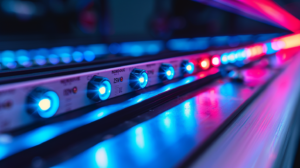
Features
- High Power LED – Batwing Type: The batwing beam pattern is designed to distribute light over a wide area, making it effective for broad illumination applications.
- 1W, 3W, and 5W Options: Offering a range of power levels to suit different lighting requirements, from subtle to intense illumination.
- Long Service Life: With an estimated lifespan of 50,000 hours, these LEDs provide prolonged and reliable service, reducing the need for frequent replacements.
- Low Luminosity Loss: Engineered to maintain their brightness over time, ensuring consistent light output.
- Variety of Emitting Colors: Available in multiple colors, enabling use in a wide array of lighting designs and aesthetics.
- Working Current Ranges: Suitable for a variety of power setups with current ranges including 200-350mA for lower wattage models, and higher currents like 700mA and 1050mA for more powerful LEDs.
- Heat Sink Options: Available with or without heat sinks. Heat sinks are crucial for managing heat in high-power LEDs, ensuring longevity and stable performance.
- RoHS Compliance: Adherence to the Restriction of Hazardous Substances Directive indicates they are manufactured without using certain hazardous materials, making them safer for the environment and human health.
Applications
- General and Task Lighting: Ideal for both residential and commercial lighting where high-intensity, broad coverage illumination is required.
- Architectural and Decorative Lighting: Their wide beam spread and color variety make them suitable for architectural features, accent lighting, and creating ambiance.
- Outdoor Lighting: Used in street lighting, public area illumination, and landscape lighting due to their powerful output and wide coverage.
- Industrial Lighting: Applicable in warehouses, factories, and large workspaces where intense and reliable illumination is necessary.
- Retail and Display Lighting: Employed in retail spaces and display cases to highlight products with bright and consistent light.
- Automotive and Signal Lighting: Suitable for use in automotive lighting systems, including headlights, for their brightness and durability.
- Specialty Lighting Applications: Used in studios, stages, and other areas requiring high-intensity lighting.


Electrical-optical characteristics:
Package configuration & Internal circuit diagram
Obtain 3D specification files
To examine all 3D specifications, save the files to your local drive and open them with your 3D application.
Lens colors in 3D files are solely for visual representation; consult the Datasheet for accurate lens type and color information.
In the event of a mismatch, the dimensions in the datasheet take precedence over the 3D specifications.

All dimensions are in millimeters(inches)
Tolerance is +-0.25(0.01″) unless otherwise note
Specifications are subject to change without notice.
Partno description:
More Information
Lens Color:
| Code | D | T | C | W | E | |
| Meaning | color Diffused | Color Tinted | Water Clear | Water Diffused | Orange diffused |
Absolute maximum ratings (Ta=25°C)
| Parameter | SR | LR | UR | UE | UY | UG | PG | BG | B | UB | UV | W | Unit |
| Forward Current I F | 25 | 25 | 25 | 30 | 30 | 30 | 30 | 30 | 30 | 30 | 30 | 30 | mA |
| Power Dissipation P d | 60 | 60 | 60 | 65 | 65 | 75 | 110 | 110 | 120 | 120 | 120 | 120 | mW |
| Reverse Voltage V R | 5 | 5 | 5 | 5 | 5 | 5 | 5 | 5 | 5 | 5 | 5 | 5 | V |
| Peak Forward Current I PF (Duty 1/10 @1KHZ) | 150 | 150 | 150 | 150 | 150 | 150 | 150 | 100 | 100 | 100 | 100 | 100 | mA |
| Operation Temperature T OPR | -40 to +80 | °C | |||||||||||
| Storage Temperature T STG | -40 to +85 | °C | |||||||||||
| Lead Soldering Temperature T SOL | Max.260+-5°C for 3 sec Max. (1.6mm from the base of the epoxy bulb) | °C | |||||||||||
Related Information
Applied for:

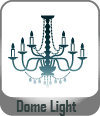
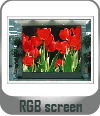
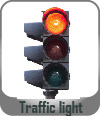
The LEDs described here are intended to be used for ordinary electronic equipment (such as office equipment,
communication equipment and household applications). Consult Betlux’s Sales in advance for information on
applications in which exceptional reliability is required, particularly when the failure or malfunction of the LEDs
may directly jeopardize life or health (such as in aviation, transportation, traffic control equipment, medical
and life support systems and safety devices).
CAUTIONS for Through-Hole LED Lamps
1. Application
The LEDs described here are intended to be used for ordinary electronic equipment (such as office equipment, communication equipment and household applications). Consult Betlux’s Sales in advance for information on applications in which exceptional reliability is required, particularly when the failure or malfunction of the LEDs may directly jeopardize life or health (such as in aviation, transportation, traffic control equipment, medical and life support systems and safety devices).
2. Storage
The storage ambient for the LEDs should not exceed 30℃ temperature or 70% relative humidity. It is
recommended that LEDs out of their original packaging are used within three months
For extended storage out of their original packaging, it is recommended that the LEDs be stored in a sealed
container with appropriate desiccant or in a desiccator with nitrogen ambient.
3. Cleaning
Use alcohol-based cleaning solvents such as isopropyl alcohol to clean the LED if necessary
4. Lead Forming & Assembly
During lead forming, the leads should be bent at a point at least 3mm from the base of LED lens. Do not use
the base of the leadframe as a fulcrum during forming.
Lead forming must be done before soldering, at normal temperature.
During assembly on PCB, use minimum clinch force possible to avoid excessive mechanical stress.
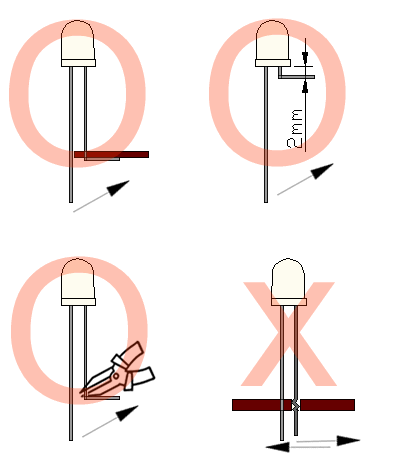
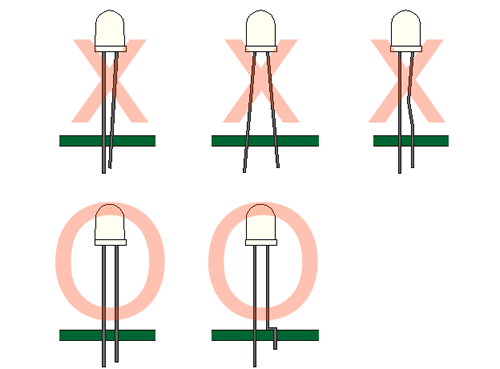
Soldering
When soldering, leave a minimum of 2mm clearance from the base of the base of the lens to the soldering point. Dipping the lens into the solder must be avoided.
Do not apply any external stress to the lead frame during soldering while the LED is at high temperature.
Recommended soldering conditions:
| IR Reflow Soldering (for SMD display) | Wave Soldering | Soldering Iron | |||
| Pre-Heat | 150-180°C | Pre-Heat | 100°C Max. | Temperature | 300°C Max. |
| Pre-Heat Time | 120sec Max. | Pre-Heat Time | 60sec Max. | ||
| Peak Temperature | 260°C Max. | SolderWave | 260°C Max. | Soldering Time | 3sec Max.(one time only) |
| Soldering Time | 10 sec Max. | Soldering Time | 5sec Max. | ||
Note: Excessive soldering temperature and/or time might result in deformation of the LED lens or failure of the LED
ESD(Electrostatic Discharge)
Static Electricity or power surge will damage the LED.
Suggestions to prevent ESD (Electrostatic Discharge):
n Use a conductive wrist band or anti-electrostatic glove when handling these LEDs
n All devices, equipment, and machinery must be properly grounded
n Work tables, storage racks, etc. should be properly grounded
n Use ion blower to neutralize the static charge which might have built up on surface of the LED’s
plastic lens as a result of friction between LEDs during storage and handling
ESD-damaged LEDs will exhibit abnormal characteristics such as high reverse leakage current,
low forward voltage, or “no light on” at low currents. To verify for ESD damage, check for “light on”
and Vf of the suspect LEDs at low currents.
The Vf of “good” LEDs should be>2.0V@0.1mA for InGaN product and >1.4V@0.1mA for AlInGaP
product.

Drive Method
An LED is a current-operated device. In order to ensure intensity uniformity on multiple LEDs connected in
parallel in an application, it is recommended that a current limiting resistor be incorporated in the drive circuit,
in series with each LED as shown in Circuit A below.
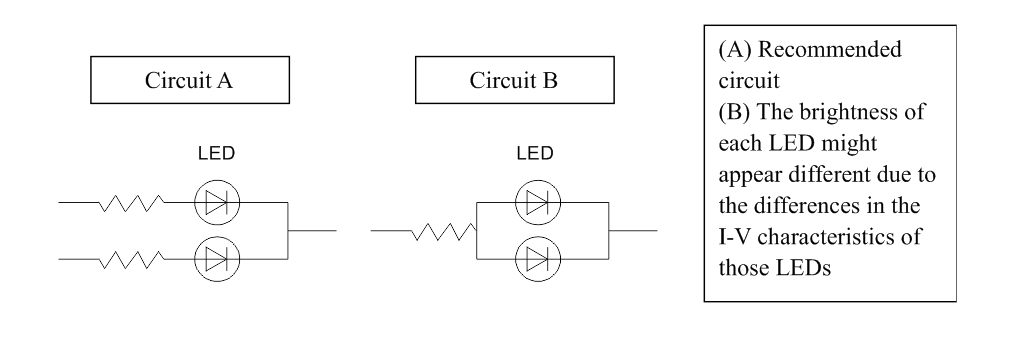
When selecting power for LED systems, it’s essential to understand several key parameters to ensure safe operation, longevity, and optimal performance. Here are some steps and considerations for LED power selection:
- Determine the Forward Voltage (Vf) of the LED(s):
Each LED has a forward voltage, which is the voltage at which the LED operates when the current is flowing through it. This value can typically be found in the LED’s datasheet.
- Determine the Forward Current (If) of the LED(s):
The forward current is the current at which the LED is designed to operate. Running an LED at higher than its rated current can reduce its lifespan and increase the heat it produces.
- Decide on the Configuration:
Series Configuration: When LEDs are connected in series, the forward voltages add up, but the current remains the same.
Parallel Configuration: When LEDs are connected in parallel, the forward voltage remains the same, but the currents add up. This configuration can be risky because if one LED fails or has a slightly lower forward voltage, it can cause the other LEDs to draw more current.
Calculate Total Power Requirements:
Power (W) = Total Forward Voltage (V) x Total Forward Current (A)
For example, if you have three LEDs connected in series, each with a forward voltage of 3V and a forward current of 20mA, the total power requirement would be:
Power = (3V + 3V + 3V) x 20mA = 9V x 0.02A = 0.18W
- Select an Appropriate Power Supply:
- Voltage Rating: The power supply voltage should match or slightly exceed the total forward voltage of your LED configuration.
- Current Rating: The power supply’s current rating should meet or exceed the total forward current of your LED configuration.
- Safety Margin: It’s a good practice to select a power supply that can provide at least 20% more power than your calculated requirement. This ensures the power supply isn’t operating at its maximum capacity, which can extend its life and ensure safer operation.
- Consider Additional Features:
- Dimming Capability: If you want to control the brightness of your LEDs, choose a power supply with dimming capabilities.
- Overcurrent and Overvoltage Protection: To protect your LEDs, select a power supply with built-in protection mechanisms.
- Thermal Management: Ensure that the power supply has adequate cooling, especially if it will be enclosed or in a location with limited airflow.
- Regulation and Efficiency:A power supply with good regulation will maintain a consistent voltage output despite variations in the load. High efficiency ensures minimal power is wasted as heat.
- Physical Size and Form Factor:Depending on where you plan to place the power supply, its size and shape may be critical factors.
In summary, when selecting power for LED systems, understanding your LED’s requirements and the configuration you plan to use is essential. Then, pick a power supply that meets those needs with some added safety margin, keeping in mind any additional features or constraints relevant to your project.
Here are some well-regarded brands in the industry:
- Mean Well: One of the most recognized brands in the LED power supply industry, Mean Well offers a wide range of products suitable for both indoor and outdoor applications. Their units often come with features like overcurrent protection, dimming capabilities, and high efficiency.
- Tridonic: A global leader in lighting technology, Tridonic offers LED drivers and power supplies that cater to various lighting solutions, from simple setups to advanced smart lighting systems.
- Philips Advance Xitanium: Philips is a well-known brand in the lighting industry, and their Xitanium series of LED drivers are known for reliability and performance. They cater to both indoor and outdoor LED applications.
- Osram: Another giant in the lighting industry, Osram offers a range of LED drivers and power supplies suitable for various applications, including architectural and street lighting.
- LIFUD: Specializing in LED drivers, LIFUD is known for its high-quality products that cater to both commercial and residential LED lighting solutions.
- MOSO: This brand offers a variety of LED drivers, especially for outdoor and industrial applications. Their products are known for durability and performance.
- TDK-Lambda: With a history in power electronics, TDK-Lambda offers a range of power supplies and LED drivers suitable for various applications, emphasizing reliability and advanced features.
Need help?
No related products found.

